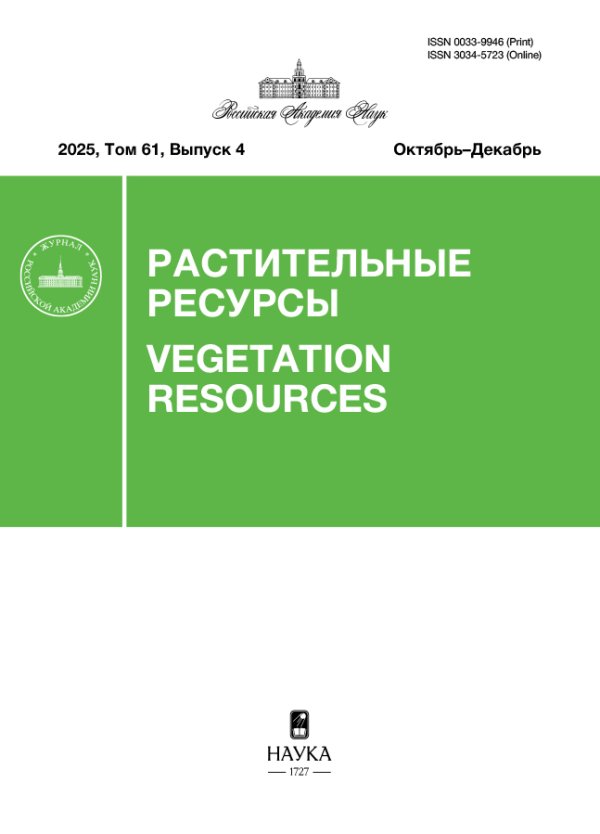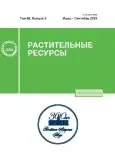Vol 59, No 3 (2023)
REVIEWS
 217-227
217-227


Component Composition and Some Features of the Biological Activity of Viscum album (Viscaceae)
Abstract
Abstract
—The review summarizes data on the chemical composition and some features of biological activity of Viscum album L. (Viscaceae Batsch). Among the secondary metabolites, the dominant ones are: viscotoxins, lectins, carbohydrates, amino acids, flavonoids, triterpene acids, nitrogenous compounds. It has been shown that European mistletoe extracts, as well as individual components, exhibit various types of biological activity, including antitumor, immunomodulatory, antidiabetic, and improve cognitive functions. V. album is very promising for further comprehensive study as a local source of herbal preparations, as mistletoe preparations are prescribed as an adjunct treatment for cancer patients in many countries.
 228-248
228-248


Resources of useful plants and Plant Communities
Stocks of Onobrychis (Fabaceae) Raw Materials in the Republic of Azerbaijan
Abstract
Abstract
—The distribution areas and resources of Onobrychis Hill species (the sainfoins) in Azerbaijan were studied. The areas of thickets and the volumes of potential annual harvesting of 19 species, out of 22 common for Azerbaijan, were determined. It was found that sainfoins occupy an area of 1059.6 ha. The biological stock of the above-ground (herb and shoots) and underground (roots) parts in the studied areas is 291.133, 33.715 kg and 317.003 kg, respectively; the exploitable volume is 198.490, 22.371 kg and 214.834 kg, respectively; the potential volume of annual harvesting is 44.624, 14.321 and 5.593 kg of air-dry raw materials, respectively.
 249-256
249-256


Biology of Resource Species
In Vitro Introduction of Lespedeza davurica (Fabaceae)
Abstract
Abstract
—Rare species Lespedeza davurica (Laxm.) Schindl. (Fabaceae), growing in the Russian Federation, was for the first time introduced into in vitro culture. Efficient sterilization protocol was selected: seeds were soaked in sulfuric acid for 25 min, then washed in distilled water 5 times for 30 s, then soaked in 1% silver nitrate solution for 25 min, then in 1% sodium chloride solution for 15 min, and washed in distilled water 3 times for 30 s. The overall seed germination was sufficiently high – 78.8%. It was observed, that cotyledon leaves in most plants appeared by the end of the first week of cultivation, true leaves – by the end of the second week, additional shoots began to form within the first month of cultivation. The resulting culture was propagated under in vitro conditions using additional shoots. The effect of thidiazuron at concentrations of 0.5 and 0.1 mL/L was traced. It was shown that Murashige and Skoog medium without growth regulators are suitable for cultivation and micropropagation of the species under study, and when the medium is supplemented with thidiazuron it can be used to obtain more plant material. The results of our study are of interest for the fundamental and applied aspects of the study of L. davurica.
 257-261
257-261


Structure of Plant Populations
State of Limonium gmelinii (Plumbaginaceae) Coenopopulations in the Republic of Khakassia
Abstract
Abstract
—The study is focused on the characteristic halophyte of Khakassia – Limonium gmelinii (Willd.) Kuntze (Plumbaginaceae). There is no information on the structure and assessment of the state of the coenopopulations of L. gmelinii in Khakassia. The materials were collected in 2022 from steppe and meadow plant communities with varying degrees of salinity. It was found that L. gmelinii coenopopulations are stable. The studied coenopopulations are normal, complete and incomplete. The left-sided type of the ontogenetic spectrum is formed in the alkaline steppe with low total projective cover and sufficient moisture; centered – on slightly saline or almost non-saline substrate of grass-covered steppe and meadow communities under different moisture regimes. The change in the ontogenetic structure and an increase in the undergrowth are associated with seed renewal and ecological and phytocenotic conditions of habitats. The density of individuals depends on the ecological and phytocenotic environment. The maximum total score of organismal and populational characters in Limonium gmelinii individuals was observed on slightly saline and practically non-saline soils in the cold sagebrush-grass and sagebrush real steppes of Khakassia. On the steppe meadows with low salinity, extensive grass cover and lack of moisture, the species does not reach the optimum. On highly saline soils, under low competition from related species and sufficient moisture, the total score of organismal and population characters reaches an average value.
 262-276
262-276


АНТРОПОГЕННОЕ ВОЗДЕЙСТВИЕ НА РАСТИТЕЛЬНЫЕ РЕСУРСЫ
State and Stability of Forest Ecosystems of the Region with Extreme Anthropogenic Transformation (Evidence from the Oka River Basin)
Abstract
Using satellite sounding data on the forest cover of Russia and three GIS programs, mapping of forest cover and average crown density in the Oka river basin was carried out. Considering hydro-ecological role of forests, these parameters were differentiated according to water management areas. The progressive decline in the wooded areas, thinning and defoliation of forest stands confirm the validity of classifying the Oka river basin as a territory with a catastrophic environmental situation. This is especially true for the forest-steppe zone, where the forest cover ranges from 2.4 to 40%. The average canopy density of the forests in the basin is 50.7%, which makes a significant part of them approaching the state of sparse hemi-xerophytic forests. Using the methods developed by the authors, the indices of the resistance and elastic-plastic stability of forests were calculated and the corresponding maps for the Oka river basin were constructed. It was found that the replacement of primary mixed and broadleaf forests with secondary small-leaved forests leads to a general increase in the dynamism of forest communities: to an increase in their sensitivity to disturbing signals and to an acceleration of ecogenetic successional changes that tend to transfer them to their previous (or new) stable state. The ordination of forest formations of the Oka river basin was carried out according to the gradients of the indices of resistance and elastic-plastic stability. The overwhelming majority of forest formations are characterized by high sensitivity to the initial signals of external disturbances, but at the same time, by sufficiently developed mechanisms of ecogenetic successions, which represent their elastic-plastic stability. This indicates the high reforestation potential of the degraded lands of the Oka basin, which makes it possible to include its forest areas in the global system of biosphere reserves. Two opposite mechanisms exhibiting the known buffer properties of the forest litter have been revealed. In response to the unfavourable impacts, the forest community switches from some leading processes of its functioning to others – from the level of autotrophic biogenesis to the level of detrital metabolism.
 277-296
277-296


Component Composition of Resource Species
Phytochemical Characteristics and Antimicrobial Effects of Nonea rossica (Boraginaceae) Extracts
Abstract
Abstract
—A phytochemical and microbiological analysis of a widespread Russian species, Nonea rossica Steven (Boraginaceae) was carried out. As an object of study, we used the aerial part (herb) of N. rossica, harvested during flowering stage from a steppe meadow in the Novosibirsk region. The qualitative composition of biologically active compounds (BAC) was determined by thin layer chromatography, using two solvent systems: ethyl acetate–ethanol–dimexide and ethyl acetate–anhydrous formic acid–glacial acetic acid–water. The quantification of their amount was carried out by spectrophotometry (flavonoids expressed as rutin, hydroxycinnamic acids – as caffeic acid, and coumarin-like compounds – as coumarin). The raw material ethanolic extracts of different concentrations (20, 40, 70 and 95%) were used in pharmacological research. Antimicrobial activity was determined by the serial dilution method. Strains of gram-positive bacteria (Staphylococcus aureus ATCC 6538 FDA 209P and Bacillus cereus ATCC 10702) and fungi – Candida albicans NCTC 885-653 were used as test cultures. The presence of bioactive phenolic compounds (hydroxycinnamic acids, flavonoids, coumarins) was established and their quantitative content was determined. It was observed that the highest yield of bioactive phenolic compounds resulted from using 40–70% ethanol as extractant. The microbiological activity of hydroalcoholic extracts from Nonea rossica herb was studied. It was determined that antimicrobial activity against Staphylococcus aureus and Bacillus cereus, and antifungal activity against Candida albicans were exhibited by 40–70% ethanolic extracts of Nonea rossica, where equal content of caffeic acid and coumarin was measured. The synergistic interaction of these compounds determines the established bactericidal and fungistatic properties of such extracts.
 297-305
297-305


Polysaccharides of Crotalaria alata and Gleditsia triacanthos as Components of a Growth Medium for Cultivation of Microfungi
Abstract
Abstract
—The study explores the possibility of using the seeds of Crotalaria alata L. and Gleditsia triacanthos L. (Fabaceae) as a growth medium stabilizer for cultivation of microfungi. A synergistic effect was achieved when agar-agar was combined with galactomannans from Crotalaria alata and Gleditsia triacanthos, in a ratio of 1.5 : 4 : 1. Such a composition made it possible to obtain a solid growth medium, similar in consistency and color to 2% agar-agar medium. To establish biological parameters of the developed medium, the spores of microfungi Stachybotrys alternans Bonord. (Stachybotrys Cordа) и Fusarium oxysporum Schr f. vasinfectum Bilai (Fusarium), were plated on the surface of the growth media using inoculation needle and incubated in a thermostat at 25–26 °C. It was shown that partial substitution of agar-agar with galactomannans contributes to the active growth of the microorganisms. The growth of the Stachybotrys alternans and Fusarium oxysporum fungal colonies on the galactomannans growth medium surpassed the control on the fifth day by 37.2 and 31.5%, and on the seventh day – by 8.7 and 11.1% respectively.
 306-313
306-313


Badrakemin and Ostol in the Roots of Ferula persica (Apiaceae) Growing in Azerbaijan
Abstract
Abstract
—New localities of Ferula persica Wild. (Apiaceae) populations in the Gobustan, Siazan and Absheron regions of the Azerbaijan were found. The coumarin compounds osthole and badrakemin were isolated and identified from the resin of F. persica roots. Badrakemin was obtained from the studied raw materials for the first time.
 314-320
314-320


Phytochemical Features of Malabaila dasyantha (Apiaceae) Aerial Parts
Abstract
Malabaila dasyantha (C. Koch) Grossh (Apiaceae) is one of the species widely used in folk medicine. However, scientific research of this species has not been carried out, and almost no information on it is found in academic scientific databases. The new distribution areas of M. dasyantha were discovered in Gadabay district, Azerbaijan. It was determined that the plant belongs to the xerophytic ecological group. The chemical composition of the species was studied, focusing on the isolation and elucidation of phytochemical structures. The aerial parts of Malabaila dasyantha were finely cut and dried at ambient conditions. The mixture of extractive substances was obtained through three consecutive extractions with acetone, each 3 days long. The resulting acetone was filtered and evaporated on a water bath, resulting in a yellow resin with a 7% yield. The resin was then dissolved in CHCl3 and chromatographed over a column of neutral Al2O3 with elution by hexane, hexane + benzene, benzene, benzene + chloroform, chloroform, and chloroform + ethanol, in different ratios. Each fraction had a volume of 100 mL, and the separation and isolation process was carried out using column (silica gel) and thin-layer chromatographic methods. The structural elucidation of the purified compounds was based on infrared spectroscopy, ultraviolet, 1H and 13C-NMR data, and compared with those previously reported in the literature. The isolated compounds from the acetone extracts of M. dasyantha were identified as scopoletin (4.3%), oxypencedanin (2.6%), isoimperatorin (3.5%), and columbianetin (2.5%). These findings may have potential applications in the fields of medicine and pharmacology. Further studies are needed to fully explore the potential of these compounds and their therapeutic properties.
 321-326
321-326












